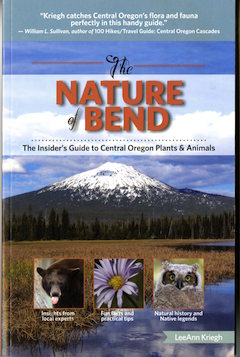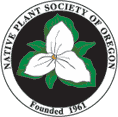Book Review
The Nature of Bend
LeeAnn Kreigh.
2016 . ISBN 978-0-9975215-0-4.
Tempo Press, Bend, Oregon.
Paper. $20.
Available from www.natureofbend.com

Touted as the “Insiders Guide to Central Oregon Plants & Animals,” The Nature of Bend is a new natural history field guide for central Oregon. The author is an outdoor enthusiast who landed in Bend several years ago and her “wonder at the sheer beauty of this place” inspired her to write a field guide to help other outdoor recreationists appreciate the natural world. As a recent immigrant to Bend myself and having seen that Bendites consider the outside as one big fitness arena, I agree this is a worthy project. I am impressed that her credentials for doing this are that she is a writer and apparently exceptionally good at cajoling those in the know to share their information and photos. She is neither a botanist nor a wildlife biologist, not even a photographer, but she has compiled a fine natural history field guide. I must add that her other qualifications include boundless curiosity and a delightful sense of humor.
Starting with plants, the author works her way through common birds, amphibians, insects, mammals, and reptiles, in that order. Would a botanist want this book? I think yes; almost half of the 260 pages of photos and descriptions feature plants. She organized them in six categories: trees, shrubs, bunchgrasses, noxious weeds, wildflowers, and a short chapter of “what the heck is that?” She consulted NPSO members Ron Halvorson, Charmane Powers, Susan Berger, Paul Slichter, Stu Garrett, and M.A. Willson, who also provided photos of the taxa they recommended for the book.
Following the wildlife section, the author includes a chapter on scavenger hunts for twelve locations within an hour’s drive of Bend. She lists categories of plants and animals, that are easy, medium or hard to find at each location.
Within the book are sidebars: Fun Facts, How to Help, Did You Know? For example, she shares Frank Spiecker’s top-ten best smelling shrubs. At the back of the book is a list of local nonprofits, a bibliography, and an index.
I have only two complaints about the book. First, the captions under the photos are so small and in light gray, blue, or red ink that I nearly needed my hand lens to read them. Second, the six-page index in the back of the book lacks names for general entries, such as squirrel, lily or marmot. If you want to look up squirrels or marmots, for example, you have to already know the names Douglas squirrel or yellow-bellied marmot. The same is mostly true for plants and birds as well. You cannot find sagebrush or sparrow under “s.” But for those who prefer to flip through the pages or just browse the book, this won’t matter.
Who would be interested in this book? Anyone who lives near or visits central Oregon who enjoys natural history or the outdoors, especially those who want to teach their children or grandchildren wonders of the natural world.
—Cindy Roché, High Desert Chapter

